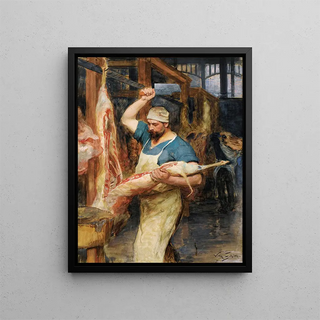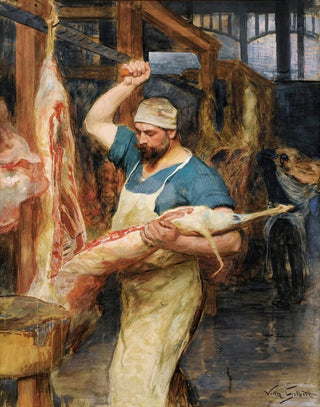Art print | The Butcher - Victor Gabriel Gilbert


View from behind

Frame (optional)
Reproduction of Le Boucher - Victor Gabriel Gilbert – Captivating Introduction
In the rich and diverse universe of art, some works stand out for their ability to capture the very essence of everyday life. "Le Boucher" by Victor Gabriel Gilbert is a perfect example. This piece, created at the end of the 19th century, immerses the viewer in a vibrant and lively scene, where the butcher's work is highlighted with an almost tangible intensity. Gilbert's composition, both realistic and poetic, invites a deep contemplation of the human condition and often overlooked trades. By observing this art print, one feels an immediate connection to the world of work and the artisans who shape it, making this reproduction an ideal choice for anyone looking to enrich their living space.
Style and uniqueness of the work
Victor Gabriel Gilbert's style is characterized by a naturalist approach, where every detail is carefully rendered to reflect the reality of his time. In "Le Boucher," warm, earthy colors evoke an atmosphere of life, while light plays a crucial role in illuminating the faces of the characters and highlighting the textures of the materials. The scene depicts not only the butcher at work but also a gallery of figures interacting in a silent ballet, each absorbed in their own thoughts and actions. This painting transcends simple representation to become a true visual narrative, revealing the social dynamics of the era and the importance of manual trades. The work stands out for its ability to transport the viewer to a frozen moment in time, where art and life meet.
The artist and his influence
Victor Gabriel Gilbert, born in 1847, was a French painter whose work is rooted in the realist movement. Influenced by masters such as Gustave Courbet, Gilbert developed a distinctive style, marked by meticulous attention to detail and a deep understanding of the subjects he depicted. His career, though less well-known than that of some of his contemporaries, left a significant imprint on the artistic landscape of his time. Gilbert was able to capture the beauty of everyday scenes, revealing the dignity of workers and artisans at a time when industrialization was beginning to transform society. His commitment to realism

Matte finish

View from behind

Frame (optional)
Reproduction of Le Boucher - Victor Gabriel Gilbert – Captivating Introduction
In the rich and diverse universe of art, some works stand out for their ability to capture the very essence of everyday life. "Le Boucher" by Victor Gabriel Gilbert is a perfect example. This piece, created at the end of the 19th century, immerses the viewer in a vibrant and lively scene, where the butcher's work is highlighted with an almost tangible intensity. Gilbert's composition, both realistic and poetic, invites a deep contemplation of the human condition and often overlooked trades. By observing this art print, one feels an immediate connection to the world of work and the artisans who shape it, making this reproduction an ideal choice for anyone looking to enrich their living space.
Style and uniqueness of the work
Victor Gabriel Gilbert's style is characterized by a naturalist approach, where every detail is carefully rendered to reflect the reality of his time. In "Le Boucher," warm, earthy colors evoke an atmosphere of life, while light plays a crucial role in illuminating the faces of the characters and highlighting the textures of the materials. The scene depicts not only the butcher at work but also a gallery of figures interacting in a silent ballet, each absorbed in their own thoughts and actions. This painting transcends simple representation to become a true visual narrative, revealing the social dynamics of the era and the importance of manual trades. The work stands out for its ability to transport the viewer to a frozen moment in time, where art and life meet.
The artist and his influence
Victor Gabriel Gilbert, born in 1847, was a French painter whose work is rooted in the realist movement. Influenced by masters such as Gustave Courbet, Gilbert developed a distinctive style, marked by meticulous attention to detail and a deep understanding of the subjects he depicted. His career, though less well-known than that of some of his contemporaries, left a significant imprint on the artistic landscape of his time. Gilbert was able to capture the beauty of everyday scenes, revealing the dignity of workers and artisans at a time when industrialization was beginning to transform society. His commitment to realism






